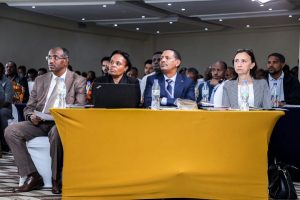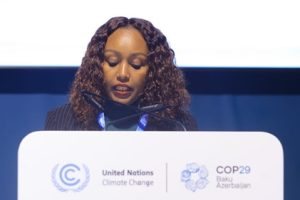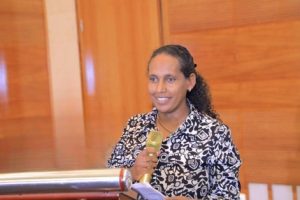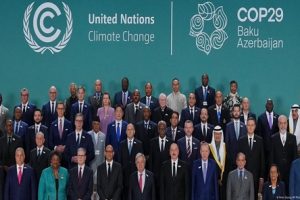COMPILED BY HAFTU GEBREZGABIHER
United Nations Secretary-General António Guterres, while addressing the COP26 Virtual Roundtable on Clean Power Transition kicked off on Jan 13 2021, Bonn Germany, stated that to achieve net zero emissions by 2050, an urgent transition from fossil fuels to renewable energy is needed. Further stressing the need for energy transition, he said that developing countries need to be supported with this shift.
On the other hand, President of the African Development Bank (AfDB) Dr. Akinumi Adesina, which is also a member of the COP26 energy transition council, outlined what the bank was doing in support of energy transition across the African continent. Africa had the lowest levels of access to energy in the world with 570 million people without electricity.
“The challenge for Africa is simple. Africa has so little electricity. This presents a real opportunity to build reliable, affordable and sustainable energy systems for Africa,” Adesina said.
This is one of the reasons why the bank had launched the Light Up and Power Africa project as one of its high 5 priorities for transforming the continent. Since 2015 the bank has provided electricity for 16 million people by focusing mainly on renewable energy.
Indeed, his comments come as just last week when the AfDB announced it would roll out a second giant electricity-generation project this time in the Sahel. It is funding the first largest solar power project in the world in Morocco.
The bank stated that the Desert-to-Power project — which covers 11 countries from Senegal in the west to Djibouti in the east, and includes the Sahel countries of Burkina Faso, Chad, Mali, Mauritania and Niger — when completed, “it will turn the Sahel into one of the largest solar-power-generating areas in the world”.
The $20-billion programme aims to produce 10 gigawatts of electricity by 2025, providing 250 million people with power, of whom at least 90 million will be connected to the electricity grid for the first time.
The bank has been at the forefront of transformative renewable energy projects in Africa, including large-scale concentrated solar power projects, in Morocco…which are the largest in the world, the wind to power project which is the largest in sub-Saharan Africa,” he said, adding that the AfDB would no longer support coal projects.
“Unlocking that renewable energy future will ensure that we have a clean Africa, however, there are some challenges,” he said, explaining that this included the intermittency of solar and wind, the need for base load power for grid stability, and the prohibitive costs of energy storage with policy and regulatory environments for renewable energy. The bank expected to invest $10 billion over the next five years in the energy sector.
But as Dr. Fatih Birol, Executive Director of the International Energy Agency (IEA) was clear to point out that the climate challenge is essentially an energy challenge. And as large polluters continue to commit to targets of net zero emissions by 2050, the world could — in theory — potentially address the climate challenge.
“The energy that powers our daily lives our economies also alone produces about 80 percent of global emissions,” Birol noted while addressing the virtual COP26 Virtual Roundtable on Clean Power Transition earlier this week on Jan. 11.
And as the UN plans to focus on building a global coalition for carbon neutrality by the middle of this current century, there will be increased focus and a push towards providing clean, renewable energy to all by 2030.
Birol said the good news was that China, the European Union, UK and Japan have ambitious 2050 net zero emission targets. It is expected that US President Elect Joe Biden would make similar commitments and other major developing nations may join. The joint global emissions by the current countries committed to the net zero emission targets amount to 60 percent of the world’s emissions.
“The issue is how to transform these ambitions into real energy action,” Birol said adding in light of this the IEA was going to introduce the world’s first roadmap to net zero emissions by 2030, scheduled to be released on May 18 so that it can be used for input for COP26.
The roadmap will outline how the world needs to transform the energy sector, how much investment is needed and what needs to be done to reach the target and “provide a concrete plan for all of us”.
Noting the figures of some 789 million people across the globe without access to electricity, majority in sub-Saharan Africa, Guterres said that while all nations need to be able to provide electricity to all, this energy needed to be “clean and renewable so that it does not contribute to the dangerous heating of our planet”.
For the IEA, while the number of people without access to electricity has decreased over past years-with some two-thirds of the world’s progress occurring in India. Its government announced that more than 99 percent of the population had access to electricity in 2019 as a result of the ambitious Saubhagya Scheme launched in October 2017. But the COVID-19 pandemic has reversed past gains particularly in sub-Saharan Africa.
“Sub-Saharan Africa, home to three-quarters of the global population without access to electricity, has been particularly hard hit, and recent progress achieved in the region is being reversed by the effects of the pandemic: our first estimates indicate that the population without access to electricity could increase in 2020 for the first time since 2013,” IEA states in its SDG7 Data and Projections report.
Damilola Ogunbiyi, CEO of Sustainable Energy for All, Special Representative of the UN Secretary-General for Sustainable Energy for All, co-chair of UN-Energy, and co-chair of the COP Campaigns Energy Transition, said it would be impossible to achieve zero emissions without delivering sustainable energy to all.
“We have to make something clear. The energy transition story is also the energy access story, especially in Africa. We must recognise that we cannot achieve net zero emissions by 2050 without delivering sustainable energy for all by 2030,” she said.
Ogunbiyi, who was the first female Managing Director of the Nigerian Rural Electrification Agency, went on to say that 2021 was a pivotal year for Sustainable Development Goal 7 which focuses on access to affordable and clean energy for all.
She said with less than 10 years to go on the SDGs, the world must “now turn towards supporting bold and ambitious plans that will deliver impact at scale to help achieve SDG 7 by 2030”. Commitments as well as financing and technical support for successful transition to renewable energy are essential.
“Both the COP26 campaign and the UN high-level dialogue on energy need to be mutually reinforcing, just as energy access and energy transition are support another,” Ogunbiyi said adding the UN energy compact — an outcome of the UN high-level dialogue on energy — would be where countries can pledge their new ambitious commitments on sustainable energy in writing.
The other interesting commitment is that UK has announced the Climate Compatible Growth (CCG) programme — a £38 million fund that will focus on supporting developing nations transition to green energy.
Dr. Amani Abou-Zeid, Commissioner for Energy and Infrastructure at the African Union said that 900 million people in Africa depended on charcoal and firewood for cooking. “This is not only an economic problem but mainly a moral issue and cause.”
Undeniably the access to energy is also about human rights. Providing renewable cooking energy to vulnerable communities across has impact on a basic human right that international communities should commit themselves and finance with passion to save the world.
The Ethiopian Herald February 2/2021





